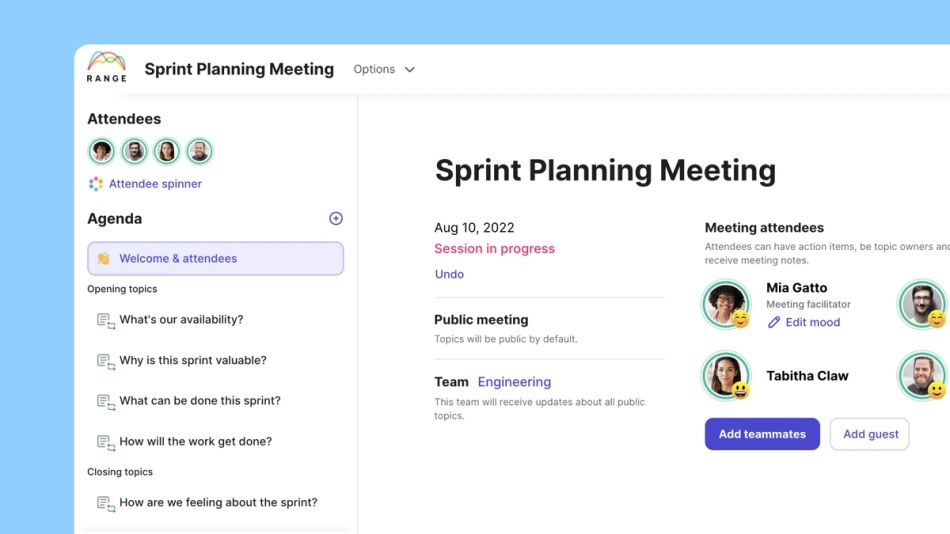If your organization is operating on sprints or transitioning to a Scrum framework, then getting the sprint planning meeting right is a top priority.
Put simply, the sprint planning meeting can make or break the entire sprint — and your project team's morale and cohesiveness.
In this brief article, we’ll define sprint planning meetings and show you why they matter so much. Then we’ll walk through seven key items to include in every sprint planning meeting.
Why is sprint planning important?
Sprint planning is essential within the Scrum framework because it sets the course for the upcoming sprint. Effectively, without sprint planning, there is no sprint. You may have a bunch of individual contributors working hard, but they won’t work as a cohesive unit toward a shared goal.
Here’s an analogy: Think of the sprint like a real-world race. You can’t just shout “Go!” into the air and expect something coherent to happen.
First, you need to set up the race: Where is it taking place? How long is the course? Where do the runners go, and where’s the finish line? Are there any unusual elements, like hurdles or batons? Who’s running, and do they know?
All that work of defining and preparing for the race is sprint planning. And it matters because the sprint cannot succeed without it.
Chris Bee, CTO of Lessen, on sprint planning:
“It’s an opportunity for us to really dive in, challenge assumptions, understand requirements, give input, and eventually settle on something we can ship together. It’s a nice touchpoint to center us back in collaboration mode,” shares Chris about how his team works.
How long is the typical sprint?
There is no formal requirement for sprint length, but most fall between one and four weeks. Arguably the most common length is two weeks, or 10 working days. Many agile teams devote a portion of every other Monday (or every Monday, in the case of weekly sprints) to debriefing from the previous sprint and planning the next one.
Some organizations operate on a fixed sprint length, where sprints are always two weeks long. Others adapt to the moment's needs and must determine a sprint’s length during its sprint planning meeting.
One of the key principles to running effective meetings is covering the right material — and nothing extraneous or unimportant. For maximum effectiveness, work to cover each of them in the sprint planning meeting that kicks off every sprint.
Sprint Meeting Agenda Key Items
⭐️ Use this sprint planning meeting template right inside Range for free.
⚡️ Take notes, assign action items, and keep your meeting history.

1. Establish the sprint goal
Before jumping into objectives or the work itself, ensure your team establishes a sprint goal. According to the Scrum Guide, every sprint should have a singular objective, called the sprint goal. All the work within the sprint should support that goal. It’s not necessarily a problem to have multiple objectives supporting the goal, and every sprint will certainly have numerous tasks to complete. But the Sprint Goal is the key.
Stefan Wolpers, a professional Scrum trainer at Scrum.org, notes that failing to set a sprint goal is unfortunately quite common, and he warns that failing to set a sprint goal demotivates teams and destroys focus.
Left unchecked, this lack of focus will eventually degrade the team into an assembly line mentality.
2. Review previous sprints and product backlog
The sprint planning meeting should include a review or debrief of the last sprint: Was it a success? Was there anything from the backlog the team expected to complete but didn’t? Were any lessons learned in last sprint’s work that suggest adjustments are needed?
Next, the team should examine the product backlog and select those tasks that contribute toward the sprint goal. This step should not be automatic or perfunctory: You should discuss why and whether each task contributes toward the goal. This step aims to narrow down which items to include in the sprint backlog.
3. Discuss team capacity
Next up is a conversation about how much the Scrum team can realistically accomplish during the sprint. If you’re the Scrum master or product owner, you’ll do some estimating here: Some task durations may be well known, but others are a bit more open-ended. When you have previous project or sprint data to pull from, do so.
Sometimes your team will end up with more tasks than they can accomplish during a sprint. This might mean the sprint goal is too broad, or it could mean that your progress toward it will only be incremental.
Also, somewhere within the previous and this step, make sure the team agrees on a definition of "done" for the sprint. This shared understanding of what success looks like will benefit everyone at the next sprint planning meeting.
4. Identify bottlenecks
Even in Agile project management, it’s possible to have task dependencies — product backlog items that can’t be finished until something else is done. When one member of the development team or an external contributor falls behind or is overallocated, you’re facing a bottleneck. It isn’t possible to proceed to an item in the sprint backlog until the bottleneck clears.
Bottlenecks aren’t ideal, but invisible or unidentified bottlenecks are much, much worse. Now is the time to discuss any bottlenecks and brainstorm solutions with team members. You may need to allocate resources differently to ease the bottleneck, or the entire Scrum team may even need to adjust what they pull from the backlog during this sprint planning session.
5. Define action items & next steps
Next is assigning specific tasks from the sprint backlog to specific resources on the team. Each team member should receive actionable next steps: which tasks or items the team member will need to complete during the sprint.
Usually, the product manager or product owner will be closely involved here as the individual who knows the scope of the product best. The Scrum Master or project manager should also facilitate with an eye toward team members’ abilities, capacity, and any upcoming dependencies on the product roadmap.
6. Establish a timeframe for the sprint
Each sprint should have a time limit, a concrete ending point where it’s time for another sprint review and then a new sprint. If you’re in a two-week sprint cadence, your team can assume the timeframe. If not, make sure the whole team understands and agrees on an ending point for the current sprint.
Usually, this ending point looks a lot like a sprint retrospective.
7. Field questions from the entire Scrum team
The final component of the sprint planning event should allow team members to ask any remaining questions related to the upcoming sprint. Team members may have questions about specific deliverables, what a successful sprint would look like, stakeholder priorities, or anything else connected to the sprint. As long as the questions remain relevant and on topic, no question should be off limits.
Check out Range’s sprint planning template today
For followers of agile methodologies like Scrum, the sprint planning meeting is one of the most crucial of all Scrum events: It sets the scope, focuses the team, and motivates all involved toward better performance.
Of course, an effective sprint planning meeting starts with a strong meeting agenda, and there will be plenty to discuss over the course of this meeting. You’ll need a place to store and track this sprint iteration and all the team plans discussed in the meeting.
- Collaborate better with more effective meetings
- Easily facilitate balanced discussions that make every meeting worthwhile
- Keep everyone included and on track with much less effort.
- Build agendas, record actions, and share notes automatically
- Create a recurring agenda for all the topics your team discusses every week from metrics to project updates.
- Empower discussion by building a collaborative agenda & spinning to select others to speak
- Easily document notes from each topic to keep everyone in the loop.
- Share notes via Slack & email
See Range in action today: Check out our powerful sprint planning meeting template now for free.
Sprint Planning FAQ
What is a sprint planning meeting? 
A sprint planning meeting is held at the kickoff (or start) of a sprint to determine what needs to be done during the upcoming sprint (and what won’t be accomplished during it).
It’s a time for the entire project team to work together, discussing the outcomes of the previous sprint and collaborating on the direction and goals for the upcoming sprint.
Sprint planning is a central part of the Scrum project management framework, and the language and concepts of sprints don’t show up in non-Agile project management frameworks.
Sprint planning meetings are tactical in nature, involving the entire team. They should be collaborative, creative events, not conducted in a top-down approach.








